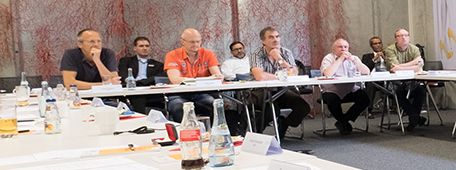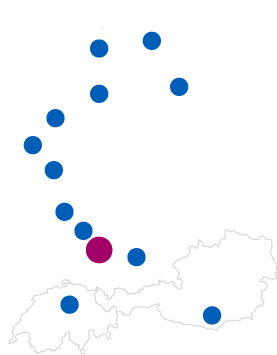City of Erlangen
Project cost controlling in the Cultural Projects office and Civil Engineering office
Challenge
When the Bavarian city of Erlangen began its launch of a fourth dimension at the start of 2013, it didn’t do so because of anything related to physics or math, but rather for a very practical reason: They wanted to better control and manage the costs of projects and response measures. Previous options for evaluating the dimensions of general ledger accounts, cost center groups, and payers were no longer enough in these offices, and they needed a “fourth dimension of evaluation” for figures from double-entry financial accounting. The goal: To link response measures directly to maintenance groups and properties and to break them down into their component parts.
A lack of flexibility in timing for controlling projects and measures was another source of headaches for project managers. “Weeks and weeks pass between the time the contract is awarded and the time the first interim or final invoice is sent, during which the system doesn’t deliver any information about budgetary funds that have already been used,” Michael Kamenaric, City Treasurer, explains. “In the fourth quarter of the year, especially, this would make it impossible to make sound decisions on whether there were still any funds free from the current year’s budget, to determine whether another order could be awarded, or whether to wait.”
Solution
Since Erlangen had already been a user of the Infoma newsystem financial software since 2009, the city of 107,000 inhabitants decided to build on that choice to create synergy effects. After a test phase run during one of its projects, they decided to use the integrated Infoma newsystem module Facility management along with the modules Basic and Measure management. Since that time, project managers in “Northern Bavaria’s high tech center” have always been up to date: Figures from financial accounting (budget items from budget planning and current figures) are constantly synchronized with figures from the Measures module. The financial accounting budget can then be used to prepare budgets for specific measures in the Measures module.
The modules are used in two very different areas. While the Civil Engineering office secured its spot as one of two pilot offices early on, expressing its interesting in more detailed mapping of its cost structures in order to achieve better controlling for measures and projects, the city had a different idea when deciding who the second user would be. “The question was whether the measure management could be used for project cost controlling in a non-technical area within the town administration,” Michael Kamenaric remembers.
There were cultural agencies, such as the Cultural Projects office and the theater, which were looking for another dimension of evaluation. The City Treasurer, however, certainly wasn’t interested in bloating the cost center group and payer plan unnecessarily by requiring other dimension values for each and every theater piece or every large cultural event – after all, Erlangen likes to think of itself as a city with a diverse, colorful, and international cultural scene. Events like the International Comic Salon, the International Puppet Theater festival, or the Poetenfest, draw visitors from all over Germany, and in some cases all over Europe. Organizing them is work-intensive, and is handled by the Cultural Project office of the town administration
Michael Kamenaric: “Ultimately, we decided to try out measure management in the Cultural Projects office because that agency showed the most interest in the project, and in our opinion at the time of the selection, it was also better set up to take it on, professionally speaking.
After the four-month test phase, based on a concept developed jointly by the City Treasury, the two pilot offices, and the Axians Infoma team, had finished successfully, there was nothing standing in the way of a go live for the solution on 1/1/2013. The intention was to initially use measure management only in non-investment related areas. That means that only those general ledger accounts for specific equipment and material budgets in the pilot offices would be included in the actual measures budgets and item booking. They planned to expand to investment budgets and bookings for investment transactions in 2013. In addition, the city also plans to expand measure controlling to the investment budget in the two departments the following year.
Before the pilot offices could go live, however, there was a challenge the City Treasury had to meet. “We started double-entry financial accounting in 2009 without budget review activated,” Michael Kamenaric explains. “To introduce measure management, therefore, we had to activate the budget review.” They first set up only the equipment and material budgets for the departments. To make sure there weren’t any problems booking items from previous years, 2009 to 2012, the project managers also only approved the budget review in a “soft” version, and set up dummy equipment and material budgets with a term from 2009 to 2012. This prevented the financial accounting budget review from rejecting postings for this time frame.
One other issue came up during live operations: Axians Infoma is currently still working on how to optimize external items recorded by central internal service providers, other city offices, or external processes. In Michael Kamenaric’s opinion, this is just one of those things you learn using a pilot application, that “Axians Infoma provides additional support in continuing to develop the product.”
Benefits
Introducing measure management has led to major changes in the process organization of the two pilot offices. For example, technical employees in the Civil Engineering office now enter orders directly in Infoma newsystem, and receive order slips back from the system. In contrast to the previous process, this requires them to determine the estimated value for an upcoming order volume much more precisely in advance.
But even if the users have to switch to other processes sometimes, after the first few months everyone involved has a positive opinion of the solution. The engineers, especially, greatly appreciate how much easier it is to enter orders – in the past, they felt all that “annoying administrative work” was preventing them from doing their actual jobs. Now they just need to enter the measure and recipient numbers into the order entry screen, and the solution automatically fills all the other data in the reservation line, such as general ledger account, cost center group, and payer, thanks to the excellent pre-configuration work done by the chief project managers in the Civil Engineering office. In Erlangen, nobody will be saying “But we’re engineers, not administration experts!” anymore.
Always up to date: The city of Erlangen synchronizes figures from Financial Accounting and the measures module
Key data
Product Measure management
State Bavaria
Number of inhabitants
107.103
Double-entry financial accounting by Infoma newsystem with Financial Accounting, taxes and fees, fixed-asset accounting, cost and results accounting, facility management, basic, and measure management.


























